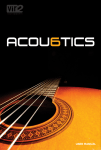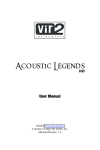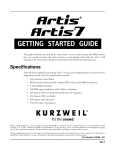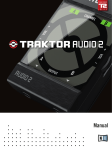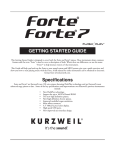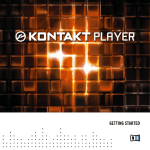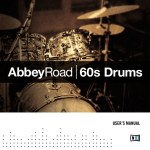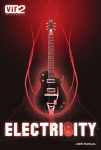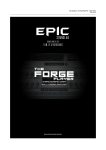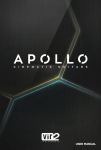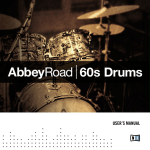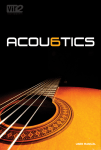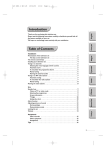Download USER MANUAL - Vir2 Instruments
Transcript
USER MANUAL Produced by Vir2 Instruments Vir2 Instruments / is an international team of sound designers, musicians, and programmers, who specialize in creating the world’s most advanced virtual instrument libraries. Vir2 is producing the instruments that shape the sound of modern music. 29033 Avenue Sherman, Suite 201 Valencia, CA 91355 Phone: 661.295.0761 Web: www.vir2.com USER MANUAL TABLE OF CONTENTS 00 FRACTURED/ TABLE OF CONTENTS CHAPTER 01 01 INTRODUCTION TO THE LIBRARY CHAPTER 02: REQUIREMENTS AND INSTALLATION 03 SYSTEM REQUIREMENTS 03 INSTALLING 04 UPDATING 04 AUTHORIZING CHAPTER 03: USING KONTAKT 05 HOW TO ACCESS THE FRACTURED LIBRARY FROM KONTAKT 05 USING KONTAKT IN STANDALONE MODE 07 USING KONTAKT AS A VST PLUG-IN IN CUBASE AND NUENDO 08 USING KONTAKT AS A VST OR AUDIOUNIT PLUG-IN IN ABLETON LIVE 09 USING KONTAKT AS AN AUDIOUNIT PLUG-IN IN LOGIC PRO, LOGIC STUDIO, LOGIC EXPRESS, ETC. 10 USING KONTAKT IN GARAGEBAND 11 USING KONTAKT AS AN AUDIOUNIT PLUG-IN IN DIGITAL PERFORMER 11 USING KONTAKT AS AN RTAS PLUG-IN IN PRO TOOLS VIOLENCE 12 USING KONTAKT AS A PLUG-IN IN ANOTHER HOST CHAPTER 04: WORKING WITH THE INSTRUMENTS 13 chromatic kits 13 DRUM KITS 14 MELODIC, PADS AND SFX (Sound Effects) 14 TEMPO SYNCED 14 instrument info 15 FX Settings and Eq buttons 15 TIP: AUTOMATING KNOBS 15 NOTE: KEY RANGES 16 NOTE: by hand (lh resonances) CHAPTER 08: TECH SUPPORT, ETC. 17 TECH SUPPORT 17 THE FULL VERSION OF KONTAKT 5 17 LICENSE AGREEMENT 18 CREDITS 00 CHAPTER 01 / INTRODUCTION TO THE LIBRARY 01 CHAPTER 01 FRACTURED/ INTRODUCTION TO THE LIBRARY FRACTURED is a multidimensional and innovative virtual instrument focusing on extremely creative and esoteric presentations of acoustic guitars Created for both musical use and sound design, FRACTURED is an innovative new collection of instruments featuring creative and esoteric samples and manipulations of various acoustic guitars. Following the tradition begun by Violence, Vir2’s virtual dismembering of a solo violin, Fractured features 2.3GB of compressed samples and more than one hundred new instruments with numerous variations and effects built into each. Each patch features the organic goodness of the acoustic guitar, but stretches its timbre in new directions to create previously unheard musical VIOLENCE effects. Drum kits were made with mallets, fingernail scrapes, metal scrapes, cardboard scrapes and pouring rice over the guitar. Long 02 evolving pads were built from acoustic guitar samples that blur the line between electronic and acoustic. Fractured also features playable and dynamic rhythmic loops and patterns, multitimbral arpeggiated creations, huge cinematic impacts, gritty electronic drums, gnarly and etherial melodic instruments, and more innovative sonic goodness. and Sound Effects, and Tempo-Synced. FRACTURED is powered by the industry-leading Kontakt engine. It is compatible with VST, AudioUnit, and RTAS (Pro Tools 8 and higher) plug-in formats allowing it to work seamlessly within any major sequencer, in addition to standalone use. CHAPTER 02 / REQUIREMENTS AND INSTALLATION 03 CHAPTER 02 FRACTURED/ REQUIREMENTS AND INSTALLATION SYSTEM REQUIREMENTS For Mac users, FRACTURED an Intel Core Duo, 2GB of RAM, a DVD drive, and OS 10.6.8 or 10.7.x. For optimum performance, Vir2 Instruments recommends a 2.0GHz processor or faster. For Windows users, FRACTURED requires Windows 7 (latest Service Pac, 32/64 Bit) Intel Core Duo or AMD Athlon 64, 2GB of RAM, a DVD drive. For optimum performance, Vir2 Instruments recommends a 2.0GHz processor or faster. The library requires approximately 2.3GB of disk space. INSTALLING The installation of FRACTURED consists of two separate steps: the installation of the Kontakt engine, and the installation of the FRACTURED library. In the FRACTURED folder, you will see the installers for Kontakt 5 and the FRACTURED library folder. Move the FRACTURED library folder to any location on your hard drive, then run the Kontakt 5 installer. The Kontakt installer will install the Kontakt engine, its standalone application, all of its plug-in versions, and the Service Center authorizer program. We recommend the Easy Install and that the install locations for VIOLENCE each component are left at their default settings. The FRACTURED library is approximately 2.3GB in size, and can be installed on any available hard drive. For speed reasons, we recommend it be installed on internal or eSATA drives. Firewire can also be acceptable. External USB 04 drives may give somewhat less optimized performance. We also recommend 7200 or 10,000rpm drives regardless of the interface used. Once Kontakt is installed, launch the standalone application, or open it as an instrument plug-in from within your preferred host application. Click on the Libraries tab from the Kontakt browser on the left side of the Kontakt interface. Just below “Libraries,” click on “Add Library.” A “Locate Folder” window will appear. Navigate to the Fractured Library folder, highlight it, then click choose. Fractured should now appear in Kontakt’s library browser. UPDATING After installation, please make sure that you are fully updated to the most recent versions of the three components that make up the FRACTURED package: the library (which contains all the patch information and programming), the engine (which is powered by Kontakt), and the authorizer (Service Center). It is possible that any of these components may have a more recent version than you originally received, so you should check for updates to each of these three. You can do this by visiting the vir2.com web site and checking the Support area. AUTHORIZING After you’ve completed installation, FRACTURED will be working in demo mode, meaning it will only work for 15 minutes at a time. To fully authorize it, launch Service Center (found in the Applications folder on a Mac, or the Program Files folder on Windows) and follow its instructions. You will be prompted to enter your e-mail address and password that make up your Native Instruments account, or will be given an option to create an account if you don’t already have one. Once inside the Service Center, it will give you a list of all the Native Instruments and NI-powered products on your hard drive and give you the option to activate them. You are allowed to install and use FRACTURED on up to two computers simultaneously. Service Center will guide you through the process for either online (instant) activation, or offline activation if the computer on which you installed FRACTURED does not have direct access to the internet. CHAPTER 03 / USING KONTAKT 05 CHAPTER 03 FRACTURED/ USING KONTAKT HOW TO ACCESS THE FRACTURED LIBRARY FROM KONTAKT FRACTURED ships as a Kontakt-powered library, and FRACTURED is opened from within Kontakt, which can be run either as a standalone application, or as a plug-in hosted by any major sequencer on either Macintosh or Windows platforms. All these versions are installed by the Easy Install option of the installer. Users who don’t own a sequencer, or would like to simply boot up and be able to play FRACTURED, can go to their Applications folder (Mac) or Program Files folder (Windows) to launch Native Instruments > Kontakt. Users who wish to use FRACTURED for sequencing or recording, or wish to play it multitimbrally, should use it in plug-in mode within a host sequencer. Kontakt supports the VST, AudioUnit, and RTAS plug-in formats. Any host sequencer that supports these plug-in formats properly will be able to use Kontakt. Instructions vary slightly from sequencer to sequencer, but the general procedure is to instantiate Kontakt as a virtual instrument plug-in, then load an FRACTURED instrument in Kontakt, then route a MIDI track to Kontakt so it can be triggered and recorded. The following instructions will help standalone and plug-in users get up and running quickly with a basic track of FRACTURED. USING KONTAKT IN STANDALONE MODE VIOLENCE The standalone Kontakt application can be found in the Applications > Kontakt 5 folder for Mac users, or Program Files > Native Instruments > Kontakt 5 for Windows users. After launching the Kontakt application for the first time, you will be presented with a dialog box to set up your audio and MIDI settings. Settings will vary for each user according to the specific setup, but the important thing is to route the audio to a valid audio device, and to set the buffer 06 reasonably low for good latency performance. We recommend 256 samples or less. The lower the latency slider, the less latency (the split second between the physical playing of the note and the sound coming out of Kontakt) will be, but the harder the computer will have to work. Typical useful values range between 128 and 256, however very fast computers may be able to handle lower values, while very slow computers may need higher values. [01] The MIDI page of the Options dialog box must be configured in order to let Kontakt know which MIDI device(s) to respond to. Kontakt will respond to up to four MIDI input ports (A, B, C, and D), so we recommend you switch one MIDI source on to Port A, as shown in the graphic below. [02] More detailed information on the setup options can be found in the accompanying Kontakt manual. Once you have completed Kontakt setup, jump ahead to the Getting Started with FRACTURED section below. 01 02 07 USING KONTAKT AS A VST PLUG-IN IN CUBASE AND NUENDO Users of Steinberg’s Cubase or Nuendo sequencers can use Kontakt as a VST plug-in. These instructions have been prepared in Cubase 5, although Kontakt may also work in earlier versions if the computer meets the system requirements. Once the project is open, go to the Devices menu and choose VST Instruments: [01] 01 When the VST Instruments window appears, click in the first available slot in which “no instrument” is listed. [02] 02 A popup menu will appear; choose KONTAKT 5. An alert box will appear asking if you want to create a MIDI track assigned to the KONTAKT 5 plug-in. Click Create. [03] VIOLENCE 03 08 The Kontakt window will appear, and a MIDI track will be created, transmitting to Kontakt’s MIDI channel A-1. When it is record-enabled, it will send any incoming MIDI played on your controller into Kontakt. At this point, you can skip down in the instructions to the Getting Started With FRACTURED section below. USING KONTAKT AS A VST OR AUDIOUNIT PLUG-IN IN ABLETON LIVE Users of Ableton Live can use Kontakt as a VST or AudioUnit plug-in, depending on the version. The functionality is the same. These instructions have been prepared in Live 7, although Kontakt may also work in earlier or later versions if the computer meets the system requirements. Once the project is open, go to the left side and click on the third icon down to show the Plug-in Devices list, then scroll to the Native Instruments folder and locate KONTAKT 5: [04] 04 Drag KONTAKT 5 into the central area where the text “Drop Files and Devices Here” is shown. The Kontakt interface will appear, and it will already be actively transmitting to Kontakt’s MIDI channel A-1. When it is record-enabled, it will send any incoming MIDI played on your controller into Kontakt. At this point, you can skip down in the instructions to the Getting Started With FRACTURED section below. 09 USING KONTAKT AS AN AUDIOUNIT PLUG-IN IN LOGIC PRO, LOGIC STUDIO, LOGIC EXPRESS, ETC. Users of Apple’s Logic can use Kontakt as an AudioUnit plug-in. These instructions have been prepared in Logic Pro 8, although Kontakt may also work in earlier versions if the computer meets the system requirements. Once inside your Logic project, go to the Track mini-menu (in the central area of your screen) and choose Track > New... [01] 01 The New Tracks dialog box will appear. Make sure Software Instrument is selected, then click Create. [02] 02 03 The new instrument track will be created. On the left side of the screen you will see the channel strip for that channel, including a fader, pan knob, and various insert slots. Locate the blank slot just below the letters “I/O” and above the output pair: [03] Click there, and a list of available instrument plug-ins will appear. Choose AU Instruments > Native Instruments > KONTAKT 5 > Stereo. [04] VIOLENCE 04 10 The Kontakt window will appear, and a MIDI track will be created, transmitting to Kontakt’s MIDI channel A-1. When it is record-enabled, it will send any incoming MIDI played on your controller into Kontakt. At this point, you can skip down in the instructions to the Getting Started With FRACTURED section below. USING KONTAKT IN GARAGEBAND Users of Apple’s GarageBand can use Kontakt as an AudioUnit plug-in. These instructions have been prepared in GarageBand 5 (which shipped with iLife ‘09), although Kontakt may also work in earlier versions if the computer meets the system requirements. Once inside your GarageBand project, go to the Track menu and choose New Track. [05] 05 06 A window with three choices will appear. Choose Software Instrument, then click Choose. [06] On the right side of the interface, the Browse tab will be showing. Switch to the Edit tab. [07] The Sound Generator will default to Piano. Click on Piano, and a popup menu will appear. Choose Audio Unit Modules > KONTAKT 5. [08] 07 Note: EQ you 08 Once to 09 the GarageBand may default to inserting effects, such as a compressor and a visual on on this track. This will color the sound. If don’t want these effects used, you can remove them. KONTAKT 5 is selected, the icon will change the AudioUnit icon (the ball with the sound waves radiating outward). Double-click on icon to bring up the Kontakt window. [09] The Kontakt window will appear, and a MIDI track will be created, transmitting to Kontakt’s MIDI channel A-1. When it is record-enabled, it will send any incoming MIDI played on your controller into Kontakt. At this point, you can skip down in the instructions to the Getting Started With FRACTURED section below. 11 USING KONTAKT AS AN AUDIOUNIT PLUG-IN IN DIGITAL PERFORMER Users of MOTU’s Digital Performer can use Kontakt as an AudioUnit plug-in. These instructions have been prepared in Digital Performer 6, although Kontakt may also work in earlier versions if the computer meets the system requirements. Once the project is open, go to the Project menu and choose Add Track > Add Instruments... [01] 01 In the resulting dialog box, click on the Unassigned pulldown menu, and choose Native Instruments > KONTAKT 5. You can also change the number of MIDI tracks to be added, if you know you will want to use more than one. [02] 02 The Kontakt window will appear, and a MIDI track will be created, transmitting to Kontakt’s MIDI channel A-1. When it is record-enabled, it will send any incoming MIDI played on your controller into Kontakt. At this point, you can skip down in the instructions to the Getting Started With FRACTURED section below. VIOLENCE USING KONTAKT AS AN RTAS PLUG-IN IN PRO TOOLS Users of Digidesign’s Pro Tools (M-Powered, LE, or TDM) can use Kontakt as an RTAS plug-in. These instructions have been prepared in Pro Tools 8, although Kontakt may also work in earlier versions if the computer meets the system requirements. 12 Once the project is open, go to the Track menu and choose New... [03] 03 In the dialog box that appears, choose the appropriate options, such as the following: create 1 new stereo Instrument Track in samples. Then click Create. [04] 04 Go to the Mix window and look at the channel strip for the instrument. At the very top is an area for Inserts A-E. [05] Click on the first of the five slots, and navigate through the popup menu to choose multichannel plug-in > Instrument > KONTAKT 5. [06] 06 05 The Kontakt window will appear. At this point, you can skip down in the instructions to the Getting Started With FRACTURED section below. USING KONTAKT AS A PLUG-IN IN ANOTHER HOST There are too many host programs to cover here in detail, but any modern sequencer that properly supports the VST, AudioUnit, or RTAS standards should be able to use Kontakt properly, and load FRACTURED within it. Consult the manual for your specific host to find out how to instantiate the Kontakt virtual instrument. CHAPTER 04 / WORKING WITH THE INSTRUMENTS 13 CHAPTER 04 FRACTURED/ WORKING WITH THE INSTRUMENTS FRACTURED is a very varied library with a diverse collection of sound types included within it. There are five root folders which contain the various instruments: Chromatic Kits, Drum Kits, Melodic, Pads and SFX, and Tempo Synced. Within these five root folders are more than eighty different and unique instruments. Each instrument contains a slightly different set of controls, according to the features which are most useful to tweak for musical manipulation. Here are some general guidelines for using the instruments. Chromatic Kits All chromatic kits come with two rows controls. Each control is set individually for each note of the kit. Notes are selected by simply pressing that note on your keyboard or midi control surface. The values of the controls for all the notes together can be saved to one of three slots and then loaded again. Use the “Set Current to Default” command to set the current knob configuration to be the new default configuration. Under the load menu it is also possible to reset a single note back to it’s default value using the “Reset Selected Note” command. DRUM KITS VIOLENCE All drum kits come with two rows controls. Each control is set individually for each note of the drum kit. Notes are selected by simply pressing that note on your keyboard or midi control surface. The values of the controls for all the notes together can be saved to one of three slots and then loaded again. Use the “Set Current to Default” command to set the current knob configuration to be the new default configuration. 14 MELODIC, PADS AND SFX (Sound Effects) Each instrument comes with a custom set of controls especially made for that instrument. Almost no two instruments are exactly alike. Each instrument has two rows of controls. The first row controls the volume envelope of the instrument. The second row is for effects. For most instruments it is possible to control the attack and release. For some instruments, it may not be practical to control the release, so there will be no release control present for that instrument. These controls are usually expressed in milliseconds but in some instances they are set to a number of quarter notes. In a few instances there may be multiple attack controls for different layers within the instrument. TEMPO SYNCED The tempo synced instruments have many of the same controls as the Melodic and Pad instruments, but with the addition of a Quantize control. This knob sets the input quantization level to help you play in perfect sync with the host tempo. Instrument info To find out more about a loaded instrument. Click on the instrument image in the lower right-hand corner of the interface. This will open an information window over the controls with a brief description of the instrument and what some of the controls on the interface do. To close the info window, click on the image to the left of the grey info box. 15 FX Settings and eq buttons To access all of the FX parameters, click on the FX Settings button. To access the the EQ, click on the EQ button. To go back to the main interface, click on the back arrow in the lower right-hand corner. TIP: AUTOMATING KNOBS Once you have played around with some of the knobs in the instruments, you’ll see that they can be used to great musical effect. If you have a MIDI controller which has additional knobs or sliders on it, you may want to remotely control the behavior of a specific knob or knobs. This can be done by right-clicking on any knob then assigning it to a CC controller. NOTE: KEY RANGES VIOLENCE Most patches in FRACTURED have been programmed to cover the entire 88-key keyboard, even though it was impossible to sample some of the extremes. Sometimes the extreme ranges of the keyboard can be musically useful, and in other cases, the stretching may not be of sufficiently high enough quality to be useful. We have chosen to standardize by stretching all possible instruments over the entire keyboard in order to give you as many options as possible. 16 note: by hand (lh resonances) By Hand (LH Resonances) is located in the Drum Kits folder. It requres a slightly different approach to playing than the rest of the instruments in the FRACTURED library. Notes above C3 trigger hand and knuckle raps on the guitar body. Below C3 are the string resonances created when the guitar is struck. Play a chord using the notes below C3 with your left hand and simultaneosly play the notes above C3 with your right hand. Just like striking the body of the guitar in different locations, playing different notes with your right hand triggers different timbres of string resonances. CHAPTER 05 / TECH SUPPORT, ETC. 17 CHAPTER 05 FRACTURED/ TECH SUPPORT, ETC. TECH SUPPORT Vir2 Instruments stands behind its products and is committed to helping you get the most out of using them. Please check the Support area of the www. vir2.com web site if you encounter any difficulties in using the product. You may also e-mail [email protected]. Before getting in touch with Vir2 Instruments regarding problems with the product, make sure you are running the latest versions of the library, engine, and Service Center. We are continuously updating and improving the product, so it is possible that there are more recent updates available that were released after the physical manufacturing of your installation disc. THE FULL VERSION OF KONTAKT 5 FRACTURED ships with KONTAKT 5 running in library mode, meaning it is fully able to play back the FRACTURED library and access the parameters detailed in this manual. Registered owners of FRACTURED are eligible for a special crossgrade discount to the full version of KONTAKT 5, which enables users to create their own libraries, import libraries in non-Kontakt formats, and access numerous deep editing features. Visit www.nativeinstruments.com for details on the Kontakt crossgrade. VIOLENCE LICENSE AGREEMENT The samples contained herein are licensed, not sold to you, the individual end user, by Vir2 Instruments. This non-exclusive, non-transferable license is granted only to the individual end user who has purchased an unopened, new, and lawfully made copy of this product from a dealer or distributor authorized by Vir2 Instruments. All samples remain the property of Vir2 Instruments and are licensed only for use in the creation of a live or recorded 18 performance that includes the licensed samples as part of a derivative musical work created by the licensed end user. This license expressly forbids resale, rental, loan, gift, or transfer of these samples in any format or via any medium, except as part of a derivative musical work. The samples may not be included, whether unmodified or as part of a derivative work, in any sample library product. Any unlicensed usage will be prosecuted to the maximum extent possible under the law. CREDITS Produced by: Vir2 Instruments Sound Design, Programming, and Scripting: Brendan Hogan Cover Design: Michael Farquharson Layout: Jody Friedericks Manual: Chris Peck Special thanks to the beta test team, who provided invaluable input to the product, and to the Native Instruments team, especially Dan Santucci, Nicki Marinic, Johannes Mai, Markus Krieg, Wolfgang Schneider, Frank Elting, and Rembert Gantke. All specifications subject to change. VIOLENCE 4 © 2011 Vir2 Instruments. All trademarks used are property of their respective owners. Specifications subject to change.




























